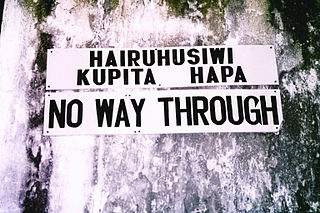Related Research Articles
The Tumbuka are an ethnic group living in Malawi, Zambia, and Tanzania. In Tumbuka mythology, Chiuta is the Supreme Creator and is symbolised in the sky by the rainbow.

The Tumbuka is a Bantu ethnic group found in Malawi, Zambia and Tanzania. Tumbuka is classified as a part of the Bantu language family, and with origins in a geographic region between the Dwangwa River to the south, the North Rukuru River to the north, Lake Malawi to the east, and the Luangwa River. They are found in the valleys near the rivers, lake as well as the highlands of Nyika Plateau, where they are frequently referred to as Henga although this is strictly speaking the name of a subdivision.

Karonga is a township in the Karonga District in Northern Region of Malawi. Located on the western shore of Lake Nyasa, it was established as a slaving centre sometime before 1877. As of 2018 estimates, Karonga has a population of 61,609. The common and major language spoken in this district is the Tumbuka language, which is also a regional language of Northern Malawi.
The Tumbuka language is a Bantu language which is spoken in Malawi, Zambia, and Tanzania. It is also known by the autonym Chitumbuka also spelled Citumbuka — the chi- prefix in front of Tumbuka means "in the manner of", and is understood in this case to mean "the language of the Tumbuka people". Tumbuka belongs to the same language group as Chewa.

At least two groups of people in Africa are described as the Yombe people. They reside primarily in Zambia, Republic of the Congo, the Democratic Republic of the Congo and Angola.Adept at crafts and art, the men are involved in weaving, carving, and smelting, and the women make clay pots. Popular figures include the Nkisi nkonde and female phemba statues.
Chitipa District is the northernmost district in the Northern Region of Malawi. The capital is Chitipa. The district covers an area of 4,288 km.², and has a population of 234,927. Chitipa borders fellow districts Karonga and Rumphi, as well as neighboring countries Tanzania and Zambia. The district is divided into five main areas known as Misuku to the east, Kameme to the north, Bulambia right at the centre while Wenya and Nthalire areas are situated to the south.
Karonga is a district in the Northern Region of Malawi. The district covers an area of 3,355 km.² and has a population of 365,028. It is a border district between Malawi and Tanzania, mainly occupied by the Tumbuka and Nkhonde tribes. Other tribes include Henga tribe.
Mzimba is a district in the Northern Region of Malawi. The capital is Mzimba. The district covers an area of 10,430 km.² and has a population of 610,944. It is the largest district in Malawi.

The Chewa are a Bantu ethnic group found in Malawi, Zambia and few in Mozambique. The Chewa are closely related to people in surrounding regions such as the Tumbuka and Nsenga. They are historically also related to the Bemba, with whom they share a similar origin in the Democratic Republic of the Congo. As with the Nsenga and Tumbuka, a small part of Chewa territory came under the influence of the Ngoni, who were of Zulu or Natal/Transvaal origin. An alternative name, often used interchangeably with Chewa, is Nyanja. Their language is called Chichewa. Internationally, the Chewa are mainly known for their masks and their secret societies, called Nyau, as well as their agricultural techniques.

Chama District with the headquarters at Chama is the largest district of the Eastern Province in Zambia and includes a large wilderness in the Upper Luangwa valley just north-east of the North Luangwa National Park. It is made up of two constituencies, namely Chama North and Chama South.
Tumbuka may refer to:
Senga may be:
The Senga are an ethnic tribe of Zambia, distinct from the Nsenga.
The Nyasa languages are an apparently valid genealogical group of Bantu languages. With the reassignment of a couple of Guthrie Zone N languages to other branches, Nyasa is essentially synonymous with Zone N. The languages and their Guthrie identifications are:

Tanzania is a multilingual country. There are many languages spoken in the country, none of which is spoken natively by a majority or a large plurality of the population. Swahili and English, the latter of which was inherited from colonial rule, are widely spoken as lingua francas. They serve as working languages in the country, with Swahili being the official national language. There are more speakers of Swahili than of English in Tanzania.
The Mwangwego script is an abugida writing system developed for Malawian languages and other African Bantu languages by linguist Nolence Mwangwego in 1977. It is one of several indigenous scripts invented for local language communities in Africa.

Tonga is a Bantu language spoken mainly in the Nkhata Bay District of Malawi. The number of speakers is estimated to be 170,000. According to the Mdawuku wa Atonga (MWATO) there are also significant numbers of speakers living elsewhere in Malawi and in neighbouring countries.
Ngoni is a Bantu language of Zambia, Tanzania, and Mozambique. There is a 'hard break' across the Tanzanian–Mozambican border, with marginal mutual intelligibility. It is one of several languages of the Ngoni people, who descend from the Nguni people of southern Africa, and the language is a member of the Nguni subgroup, with the variety spoken in Malawi sometimes referred to as a dialect of Zulu. Other languages spoken by the Ngoni may also be referred to as "Chingoni"; many Ngoni in Malawi, for instance, speak Chewa, and other Ngoni speak Tumbuka or Nsenga.

Chasefu District is a district of Eastern Province, Zambia. It was made independent from Lundazi District in 2018.

Lumezi District is a district of Eastern Province, Zambia. It was made independent from Lundazi District in 2018.
References
- ↑ "Request for New Language Code Element in ISO 639" (PDF). Retrieved 2024-02-10.